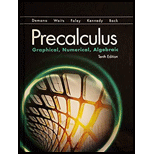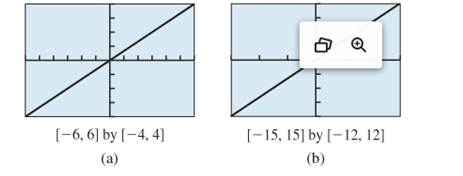
Concept explainers
Check which line has the greater slope.
The slope of the line in figure (b) is greater.
Given information:
Given figure is:

Formula used:
The slope of a line passing through two points,
Calculation:
To find which line has the greater slope, fin the slope of each line in given figure using the formula for the slope of a line passing through two points
For line in figure (a), according to the given figure the line passes through the origin, i.e. (0,0) and also through the end point, that is according to the given dimension of the graph is (6, 4), and
Thus, taking two points through which the line is passing through, as (0,0), and (6, 4) find the slope as:
Thus the slope of the line in figure a is
Now similarly, in figure (b), according to the given figure the line passes through the origin, i.e. (0,0) and also through the end point, that is according to the given dimension of the graph is (15, 12), and
Thus, taking two points through which the line is passing through, as (0,0), and (15, 12) find the slope as:
Thus the slope of the line in figure (b) is
Thus, the slope of the line in figure (b) is greater.
Chapter P Solutions
EBK PRECALCULUS:GRAPHICAL,...-NASTA ED.
 Calculus: Early TranscendentalsCalculusISBN:9781285741550Author:James StewartPublisher:Cengage Learning
Calculus: Early TranscendentalsCalculusISBN:9781285741550Author:James StewartPublisher:Cengage Learning Thomas' Calculus (14th Edition)CalculusISBN:9780134438986Author:Joel R. Hass, Christopher E. Heil, Maurice D. WeirPublisher:PEARSON
Thomas' Calculus (14th Edition)CalculusISBN:9780134438986Author:Joel R. Hass, Christopher E. Heil, Maurice D. WeirPublisher:PEARSON Calculus: Early Transcendentals (3rd Edition)CalculusISBN:9780134763644Author:William L. Briggs, Lyle Cochran, Bernard Gillett, Eric SchulzPublisher:PEARSON
Calculus: Early Transcendentals (3rd Edition)CalculusISBN:9780134763644Author:William L. Briggs, Lyle Cochran, Bernard Gillett, Eric SchulzPublisher:PEARSON Calculus: Early TranscendentalsCalculusISBN:9781319050740Author:Jon Rogawski, Colin Adams, Robert FranzosaPublisher:W. H. Freeman
Calculus: Early TranscendentalsCalculusISBN:9781319050740Author:Jon Rogawski, Colin Adams, Robert FranzosaPublisher:W. H. Freeman
 Calculus: Early Transcendental FunctionsCalculusISBN:9781337552516Author:Ron Larson, Bruce H. EdwardsPublisher:Cengage Learning
Calculus: Early Transcendental FunctionsCalculusISBN:9781337552516Author:Ron Larson, Bruce H. EdwardsPublisher:Cengage Learning





